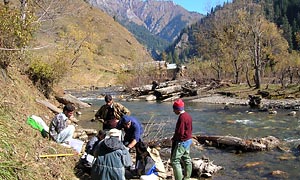Ecological effects and fishery conservation implications of a quasi-natural fish barrier on the Lower San Juan River, Utah
Date:
2018-2020
Abstract:
Most of the world’s large river systems now experience some degree of longitudinal fragmentation. Such fragmentation often alters function of stream network ecosystems to the detriment of global freshwater biodiversity. In the Colorado River basin, decreased riverine connectivity is among a suite of factors implicated in the decline of endemic migratory fishes. Our research is focused on how fish communities and species interactions differ across a longitudinally fragmented section of the San Juan River near its interface with Lake Powell with important implications for assessing future management deicsions. The Piute Farms Waterfall on the San Juan River in Utah is a “new” barrier to upstream fish movement resultant of sediment deposition and subsequent decreases in reservoir elevation (e.g., the river chose a new path over a sandstone cliff). This barrier currently bisects federally-designated critical habitat of the endangered migratory fishes Colorado Pikeminnow Ptychocheilus lucius and Razorback Sucker Xyrauchen texanus. Sampling immediately below the barrier suggests that the waterfall may be interrupting seasonal migrations not only of these imperiled species, but also of non-native piscivorous fishes not currently inhabiting the well-studied reaches above. Either restoration of stream connectivity or, conversely, maintenance of useful barriers may be appropriate tools for fishery management. In the case of Piute Farms Waterfall, the importance of longitudinal connectivity and value of lacustrine and inflow habitats to native fishes must be weighed against the potential impacts of resumed invasions by non-native species from Lake Powell. Our goal is to evaluate ecological impacts of this barrier - both beneficial and detrimental to conservation of native fishes - and provide insight into possible fish passage scenarios. Over the next two years, we will quantify fish community structure and seasonal dynamics in the river above and below the waterfall. We will also investigate interspecific interactions on either side of the barrier by quantifying non-native fish diet composition and, via stable isotope analyses, fish community trophic structure on either side of the barrier. Additionally, we will develop a population viability model to quantify effects of potential fish passage scenarios on the greater fish community of the San Juan River. Elucidating the impacts of this barrier on native fish populations and potential species interactions will inform management decisions regarding the waterfall (i.e., should fish passage be considered?) as well as other future endangered fish recovery efforts.
Funding:
- US Bureau of Reclamation
- Utah Division of Wildlife Resources
- United States Geological Survey – Utah Cooperative Fish and Wildlife Research Unit (In-kind)
Investigators:
- Phaedra Budy, Principle Investigator, USGS – UTCFWRU, USU – Dept. of Watershed Sciences & Ecology Center
- Mark McKinstry, Biological Scientist, U.S. Bureau of Reclamation
- Zach Ahrens, Biologist - Utah Division of Wildlife Resources & M.S. Graduate Candidate , USU




